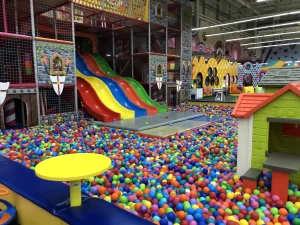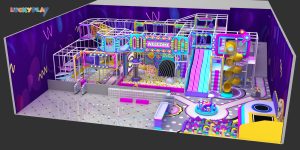Introduction
In recent years, climbing has grown beyond its niche roots to become a widely celebrated activity for all age groups. From indoor climbing gyms to backyard climbing walls, this adventurous form of movement is capturing the attention of parents and educators looking to enrich children’s physical and mental development. Among the standout additions to modern play environments is the children’s climbing wall. A colorful, interactive structure that promotes much more than just fun.
Whether installed in homes, schools, or public playgrounds, climbing walls are now being recognized as essential tools for promoting gross motor development, confidence-building, and imaginative play in children. In this article, we’ll explore the types, benefits, safety features, and best practices for integrating climbing walls into children’s environments.
- What Is a Children’s Climbing Wall?
A children’s climbing wall is a thoughtfully designed vertical or angled surface created specifically to meet the developmental needs, safety requirements, and physical abilities of young children can be typically ranging from toddlers to pre-teens. It functions as a scaled-down version of a full-sized rock-climbing wall, offering a manageable challenge that allows children to engage in active, purposeful play.
Unlike traditional climbing walls used by adults, which often reach heights of 10 to 15 feet or more and require harnesses, ropes, and belay systems, children’s climbing walls are usually much shorter in height, often ranging from 3 to 8 feet, depending on the child’s age group. This reduced height helps eliminate the fear of falling and minimizes the risk of serious injury, making it safer and more approachable for first-time climbers.
Children’s walls are brightly colored and visually stimulating, featuring a variety of fun, engaging handholds and footholds shaped like animals, stars, numbers, or geometric patterns. These holds are strategically placed to promote the development of motor coordination, balance, and spatial awareness while keeping the activity playful and imaginative.
Another defining feature of a children’s climbing wall is its emphasis on safety and accessibility. These walls are typically installed with thick crash mats, foam flooring, or padded play surfaces below to cushion any falls. The materials used are also child-friendly—often made from non-toxic, splinter-free wood, composite panels, or molded plastic that can withstand wear and tear while being gentle on little hands.
Children’s climbing walls can be:
- Mounted indoors (e.g., in playrooms, classrooms, gyms, or therapy centers)
- Freestanding outdoors in playgrounds or backyards
- Incorporated into multi-activity play structures, such as jungle gyms or obstacle courses
Some models are even modular, allowing parents or educators to rearrange or replace holds and panels as children grow or gain confidence, making it a versatile and long-lasting addition to any child-friendly space.
Importantly, these walls are not just recreational tools. They are developmental assets that support physical fitness, mental resilience, emotional confidence, and social interaction in a safe, structured environment. Whether a child is climbing as part of a physical therapy session, exploring their limits in an indoor play center, or simply having fun at home, a climbing wall provides the perfect blend of movement, challenge, and joy.
These walls can be:
- Indoor or outdoor
- Vertical or angled
- Free-standing or wall-mounted
- Constructed from materials like wood panels, fiberglass, or modular plastic boards
Often used in combination with soft play areas or obstacle courses, they encourage open-ended, unstructured movement in a controlled and stimulating environment.
- Types of Children’s Climbing Walls
Children’s climbing walls come in various forms, each with unique advantages and challenges. Choosing the right type depends on the setting, age group, and intended purpose.
- Indoor Climbing Walls
Perfect for homes, schools, and indoor play centers, these walls are usually smaller and feature bright, playful designs. They are a popular fixture in:
- Montessori schools
- Daycare centers
- Pediatric therapy clinics
- Playrooms
Advantages:
- Weatherproof and usable year-round
- Easy to supervise
- Often paired with foam flooring for added safety
- Outdoor Climbing Walls
Typically, larger and made with weather-resistant materials, outdoor climbing walls are commonly found in playgrounds and adventure parks.
Advantages:
- Provide full-body workouts in natural light
- Can be part of larger playground installations like climbing domes or jungle gyms
- Encourage social play and teamwork
- Bouldering Walls
Bouldering walls are climbing structures without ropes or harnesses. They are lower in height (usually 3 meters or less) and rely on thick mats for safety.
Best for:
- Promoting creativity in movement
- Teaching children how to fall safely
- Building strength and problem-solving skills
- DIY Home Climbing Walls
Parents and caregivers can create safe, small-scale climbing walls at home using plywood panels and climbing holds. These are often customized to fit into a child’s bedroom, hallway, or backyard.
Features may include:
- Themed colors and shapes (e.g., animals, numbers, geometric forms)
- Adjustable difficulty levels
- Soft flooring or gym mats for landing
- Developmental Benefits of Climbing Walls for Children
Climbing is a full-body experience that integrates physical, emotional, and cognitive development. Let’s break down the key benefits.
- Physical Development
- Gross Motor Skills: Climbing enhances large muscle development in the arms, legs, back, and core.
- Coordination: Reaching and gripping requires coordination between eyes and hands, as well as between limbs.
- Balance and Posture: Navigating vertical surfaces strengthens the muscles responsible for posture and balance.
- Endurance and Strength: Regular climbing builds stamina and improves muscular strength in a functional way.
- Cognitive Development
- Problem-Solving: Children must choose the best route to climb, evaluate which handhold to grab, and plan their next steps.
- Spatial Awareness: Navigating the space helps children understand directions, positioning, and movement.
- Memory and Sequencing: Remembering successful routes and sequences fosters memory retention.
- Emotional and Social Development
- Confidence Building: Reaching the top of a climbing wall is an empowering moment, helping children overcome fears.
- Risk Assessment: Climbing teaches calculated risk-taking in a controlled setting.
- Resilience: Falling and trying again builds perseverance.
- Cooperative Play: Children can encourage each other, take turns, and share strategies, fostering teamwork and communication.
- Climbing Walls and Inclusive Play
A well-designed climbing wall can be inclusive for children of all abilities. With thoughtful planning, even those with physical, sensory, or cognitive disabilities can benefit.
Features of Inclusive Climbing Walls:
- Varying wall angles to accommodate different ability levels
- Tactile handholds with different textures for sensory stimulation
- Visual cues such as color-coded paths or glowing holds for low-vision users
- Wider base areas and handholds for children who use mobility aids
Therapists often use children’s climbing walls as therapeutic tools in occupational therapy, particularly for children experiencing motor delays, developmental coordination disorders, or neurological conditions such as cerebral palsy, autism spectrum disorder (ASD), or sensory processing disorder (SPD). These walls provide a playful yet structured environment where therapeutic goals can be addressed through purposeful activity.
From a physical development perspective, climbing engages multiple muscle groups simultaneously, making it an excellent full-body workout for children with low muscle tone or postural instability. Reaching for handholds and pulling the body upward promotes upper body strength, while supporting one’s weight on the wall activates the core muscles, enhancing balance and postural control. Gripping different shapes and textures of climbing holds also improves fine motor strength and dexterity, which are crucial for daily tasks like writing, buttoning clothes, or using utensils.
In addition to physical benefits, climbing walls are particularly effective for sensory integration therapy. The dynamic movement and shifting weight that occurs during climbing stimulate both the vestibular system (responsible for balance and spatial orientation) and the proprioceptive system (which helps the body understand its position and movement in space). For children who are either sensory-seeking or sensory-defensive, climbing provides structured sensory input in a way that can be calming, regulating, and organizing for the nervous system.
- Safety Considerations
While climbing offers many benefits, safety is paramount. Here are some essential safety features and protocols:
- Wall Design and Installation
- All handholds must be securely fastened and made of non-toxic, durable materials.
- The wall structure should be built by certified professionals, especially in public or school settings.
- Avoid sharp edges or protruding bolts that could injure children.
- Proper Padding and Flooring
- Crash mats or foam-padded flooring should extend several feet from the wall’s base.
- Use high-density foam with sufficient thickness to absorb falls.
- Outdoor climbing areas can use engineered wood fiber, rubber mulch, or rubber mats as fall-safe surfaces.
- Supervision and Rules
- Always ensure adult supervision, especially for young climbers.
- Establish clear climbing rules: one climber at a time, no jumping from the top, use designated holds only.
- Encourage spotting techniques: older kids or adults can assist climbers by guiding or catching if necessary.
- How to Encourage Safe and Engaging Climbing Play
Introducing a climbing wall into a child’s environment can seem daunting at first, but with the right strategies, it becomes a beloved activity.
- Start with Low Heights
For beginners, keep the wall low and gently sloped. This builds comfort and familiarity.
- Use Visual Challenges
Color-code handholds to create “routes” of varying difficulty. For example:
- Green = easy
- Blue = medium
- Red = hard
This adds a puzzle-solving element and encourages skill progression.
- Offer Praise and Celebrate Progress
Highlight every success, no matter how small. “You reached the yellow hold today!” can mean the world to a hesitant climber.
- Rotate Handholds
Change the configuration every few weeks to create new challenges and prevent boredom.
- Combine with Other Activities
Pair the climbing wall with monkey bars, rope nets, or slide exits to create a complete adventure circuit.
- Climbing Walls in Schools and Playgrounds
Many modern schools now incorporate climbing walls into PE classes and recess areas. Here’s why:
Educational Value
- Climbing fits into STEM programs as kids learn about angles, friction, and force.
- Teachers can use climbing walls as part of themed lessons (e.g., “mountain explorers,” “space missions,” or “rescue missions”).
Behavioral Benefits
- Active children often demonstrate better focus and reduced behavioral issues after engaging in physical play.
- Children who climb frequently tend to show improved mood, as climbing releases endorphins and reduces stress.
Social Integration
Children’s climbing walls serve not only as physical and developmental tools but also as powerful environments for social inclusion and interpersonal growth. For many children especially those who may not feel comfortable or confident participating in team-based or competitive sports, climbing walls offer an alternative space where they can thrive on their own terms while still engaging with peers.
One of the most important aspects of a climbing wall is that it provides a level playing field. Success on the wall is based less on traditional athleticism like speed, agility, or strength and more on focus, persistence, problem-solving, and effort. This means that children who might struggle with fast-paced sports like soccer or basketball can still find success and validation on a climbing wall by approaching each challenge at their own pace. The lack of direct competition creates a low-pressure environment where children feel safe to try, fail, and try again without fear of judgment.
- Design Tips for Building a Children’s Climbing Wall at Home
For families interested in a DIY wall, consider the following steps:
Planning
- Choose a safe location: a garage, playroom, hallway, or backyard.
- Measure the area and draw out the climbing zone.
- Select wall height (typically 4 to 6 feet for young children).
Materials
- ¾-inch plywood or modular panels for wall surface
- Climbing holds (screw-in or bolt-on)
- Impact-absorbing flooring (gym mats, foam tiles, crash pads)
- Optional: paint, stencils, LED lights, rope elements
Installation
- Secure wall panels to wall studs or freestanding frame
- Space handholds appropriately for your child’s reach
- Add safety padding along the bottom and surrounding area
Conclusion
Children’s climbing walls are far more than just a trendy addition to playgrounds or playrooms. They are developmental powerhouses that build physical skills, foster independence, inspire creativity, and promote holistic well-being. Whether indoors or outdoors, store-bought or DIY, climbing walls bring adventure into children’s everyday lives in a safe and exciting way.
As parents, educators, and designers continue to innovate, these walls will evolve to become more inclusive, interactive, and imaginative, ensuring that every child regardless of ability, has the chance to climb, explore, and grow.




